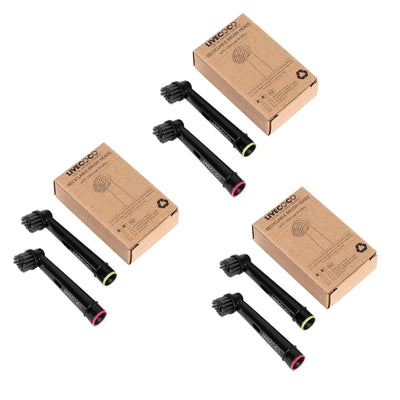When Should You Change Your Brush Head?
So, you’ve finally done it: you’ve finally bought an electric toothbrush.
They’re the new thing, and rightfully so. Normal toothbrushes are not biodegradable and end up polluting the sea or land. On the other hand, electric toothbrushes help reduce waste by only having you change toothbrush heads. But how often should you change these brush heads?
Worry not; we’re here to solve your problem. In this article, we’ll be discussing why you should change your brush head, how often you should do it, and how you can prolong your brush head’s life. So here we go.
Whether we like it or not, toothbrushes are an essential part of how we start our day. Our interactions are regular and constant, to the point that we take them for granted. Although underappreciated, these heroes do more for us than we care to mention. They give us our seamless smiles by keeping our teeth rot and plaque-free. They also keep our breaths bearable, making sure the world does not fall into anarchy and chaos. They also do a much more important job of keeping us safe from unwanted and dangerous bacteria and fungi. In this manner, they are no less than superheroes in our lives.
Like most superheroes, they may seem invincible. But like most superheroes, toothbrushes also have weaknesses and also need to be taken care of. Superman had his kryptonite, and toothbrushes have wear and tear. After all, who doesn’t get affected by wear and tear? Brush heads have their bristles frayed after constant use, and this affects their ability to do what they’re tasked to do. A brush head without healthy bristles is like Thor without his hammer. Frayed bristles inhibit their ability to remove plaque as well as fight against germs, as many studies have shown. Therefore, brush heads need to be taken care of and replaced in a timely manner.
When should you change your brush head?
Unfortunately, most people only think about changing their brush heads once they can visibly see the wear and tear. This means that they may spend months using a brush head that is not effective at fighting bacteria. What is worse is that these brush heads might have accumulated tonnes of bacteria and fungi during that time. Not all bacteria are visible, and you’re risking using a brush head that is giving you more germs than it is taking away. In this way, using an old brush head can be counterproductive to the whole idea of brushing your teeth.
Hindsight is always 20/20, but how can you know your brush head is past its life when you’re using it?
Well, the American Dental Association says that you should change it every three months. The Oral Health Foundation agrees with them, giving an extra month as the upper bound. Both agree that the effectiveness of a brush head falls greatly once its bristles get frayed and must be replaced as soon as possible. However, exceptions exist for a number of different reasons.
1. Getting sick
If you’ve gotten sick recently, you should change your brush head as quickly as possible. Getting sick leads to a range of different germs in your mouth, which, of course, leads to a lot of germs in your toothbrush. While the germs in your mouth are killed, those in the brush head might remain for a long time. Using such a brush means that you’re putting yourself at risk of getting infected again. The conditions in the bathroom are especially helpful to the bacteria in not only maintaining it but also helping it grow. This time, you might end up ingesting a larger colony of bacteria and getting even sicker than before. No one wants that for themselves, and we don’t want that for you.
2. Your maintenance of the brush head
If the maintenance of your brush head is below par, you should change it often. Of course, the bathroom is like a playground for germs. If you leave your brush head on the sink often, you should change it every now and then. You’re allowing the dirty air to transport bacteria onto your brush head. Moreover, the conditions of the bathroom might help bacteria grow. If you have warm corners in your bathroom, they’re probably a breeding ground for bacteria. So, if you’re keeping your brush head on the sink for long periods of time, you should change it before you hit the three-month mark.
Before we move on, what is the right way to maintain your brush head?
The right way is to keep it in a sealed container away from the bathroom. If you can’t do that, the least you can do is properly wash your brush and keep it away from the warm corners of your bathroom. You should keep it in a cold, dry spot to ensure the least growth of bacteria.
3. Your manner of use
Everyone’s method of using the brush will differ, and so will the replacement time. You must consider the following two questions: how hard do you brush, and how long do you brush for?
For the first question, more means the lower life of your brush head. If you’re applying too much pressure while brushing, you’re risking your bristles getting frayed sooner. When that happens, the effectiveness of your brush head will fall, and you will need to replace it. However, we’ll tell you not to brush with too much pressure for a variety of other reasons. Applying too much pressure does not mean cleaner teeth, and it can be counterproductive in many cases.
For the second question, the principle holds true again. Longer brushing time does not mean whiter teeth, but it does mean your brush head needs replacement sooner. Be careful of using the brush for too long or too hard because you’re risking your brush head's life. If you’re thinking of replacing your brush head, you should consider our very own charcoal-bristled, recyclable brush heads. We also have a variety of other brush heads, such as soft-bristled brush heads.



